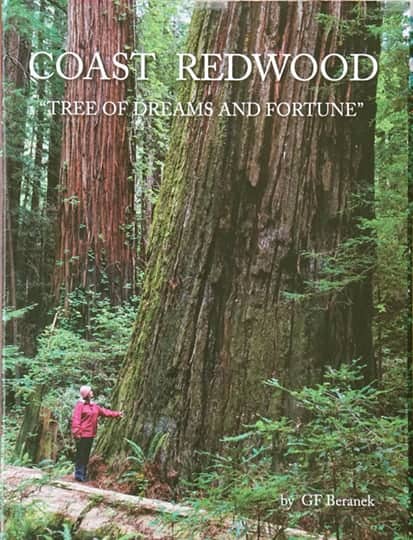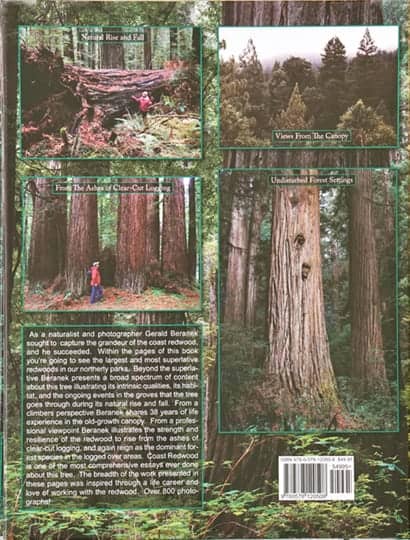
Coast Redwood
Front Dust Jacket

Coast Redwood
Back Dust Jacket

Coast Redwood
Hard Cover
$30.00
plus shipping
Coast Redwood is a hard cover book, forest green in color, with a foil stamp title on the front and spine. Big 9 x 12 inches, 302 pages and over 600 full-color images. For lasting projection this big book comes with a durable 100# glossy full-color dust jacket. Quality, cover to cover. Makes a swell gift.
Read more about Coast Redwood Read About the Author Read From Tiny Seed
tree top
Goose Ridge Tree

Rugged Redwood Coast
Coast Views Mendocino County

Coast Redwood
Underwood Tree Mendocino County

Montgomery Woods Mendocino County





Sierra Redwood
COAST REDWOOD
TREE OF DREAMS and FORTUNE
What is it about this tree? It’s hard to nail down, but the way I see it the redwood is the embodiment of time and manifestation of life in the cosmos. Everyone sees it a little bit different.
‘Coast Redwood’ is the most comprehensive, single volume, pictorial essay ever compiled about this tree, and it begins with a highlight tour across its northern range — The premier groves from the Oregon border to Mendocino County, and then farther south later to the Santa Lucia Mountains of Big Sur. 600 miles along the California coast. The northern most groves, for increased rainfall, produce the largest / tallest redwoods.
So much can be said about the northern groves I wrote a complete series of books about them.
The real weight of this book, (over 4 pounds) focuses on the intrinsic qualities of the redwood. Examining a multitude of genetic and physiological expressions unique to it, and weighing the natural events that go on in the groves, which ultimately shape the redwood throughout it’s life.
Genetically the redwood is a highly variable tree in all its characters. Like rhododendrons and roses there’s more than one kind of redwood, and with this I compare a multitude of genetic characters observed in its leaves, branchlets, limbs, bark and growth habit, and you thought you knew the redwood.
Physiologically the redwood responds to changes in its environment. As noted differences in latitude affect the stature of this tree. At either end of its natural range the redwood responds directly to local soil types, slope exposure, prevailing winds and immediate water availability. Every environmental factor, and combination there of, produces a uniquely different type redwood.
Natural events in the groves amount to fire, drought, storm, flood, collisions, lightening, and disease. Given a thousand years of repeated cycles of these events some redwoods end up broken and burned wrecks, and some survive 2,000 years totally unscathed. The good, the bad and the ugly. Examples abound.
The point of it all is — when you look up at a thousand year old redwood tree… what about it is the result of genetics? What about it is the result of physiological responses? And what about it has been shaped by natural events? The answers to these 3 questions, or better the range the possibilities you could expect, are revealed in this book, and much of what I show and tell has never been presented in a single volume about this tree before.
One chapter looks at the Giant Sequoia, or Sierra Redwood. Cousin to the coast redwood. Did you know 60,000 years ago both species of redwood grew widespread across the northern hemisphere. But the last glacial maximum reduced the natural range of both to what it is today. Not much! Fossil evidence clearly shows the last ice age was as close as it could get to a full-on natural extinction event for both trees. Seriously. We are lucky to still have these trees around today.
Another chapter looks at climbing the old-growth redwood. Called “Recreational Climber.” This a timeline about the people that have been involved in the activity. Despite what National Geographic says about it climbing the big redwoods actually began in the mid 1960s, spearheaded by a small group of professors at the university of San Jose.
As a professional tree worker I began climbing these trees in the early 1970s, up through 2007, and in this chapter I show and tell how I did it, and progressed to using non-invasive techniques. And through this chapter I present views and opinion on the issues being raised over this activity.
Another chapter looks at our second-growth redwood forests. Which constitutes 90 percent of the redwood forest lands in California. Of so much I focus on the groves along the Navarro River in Mendocino County, which were clear-cut logged in the 1860s. Going on 170 years. Today the redwoods in Navarro average 5 to 7 foot in diameter, with many exceeding 250 feet in height! That’s larger and taller than most old- growth redwoods in southern California. And as redwoods go those in Navarro are just babies.
So much about the redwood in one big book. A wealth of information.
Coast Redwood is a hardcover book, forest green in color with a foil stamped title on front, back and spine. Big 9 by 12 inches, 302 pages. Over 600 full color images. And for lasting protection this big redwood book comes with a 100# full-color dust jacket.
Only $30.00 plus shipping
